Related Podcast
Robert Wood on Rebuilding a Collapsed Dock at the Port of Beaumont
NR Editors Aileen Cho and Jeff Yoders talk to the McCarthy project manager on how a team dealt with nearly zero-vision conditions to remove old concrete and steel—with the help of a robot vessel named Little Dude.
More than a decade after the Port of Beaumont’s Main Street Terminal 1 collapsed due to corrosion of steel support piles, construction crews and engineers are undertaking a rebuild and expansion of the Texas site using more resilient materials and the latest technology.
McCarthy Building Cos. was hired to demolish a failed dock structure and reconstruct the new general cargo dock and terminal at the fourth-busiest U.S. shipping port. Completion of the $57-million project is set for late next spring. When completed, the dock will measure 15% larger than the old one.
Robert Wood, McCarthy senior project manager. describes the damaged dock as looking “sheared,” with most of the structure underwater. It was an “inconsistent structural failure and highly unstable,” he says.
But before a single pile could be slammed into the bottom of the Neches River, Wood says a “unique and challenging” job had to be completed—demolition and removal of the partially collapsed concrete dock built in the 1950s atop remnants of a timber structure that dates to the early 20th century.
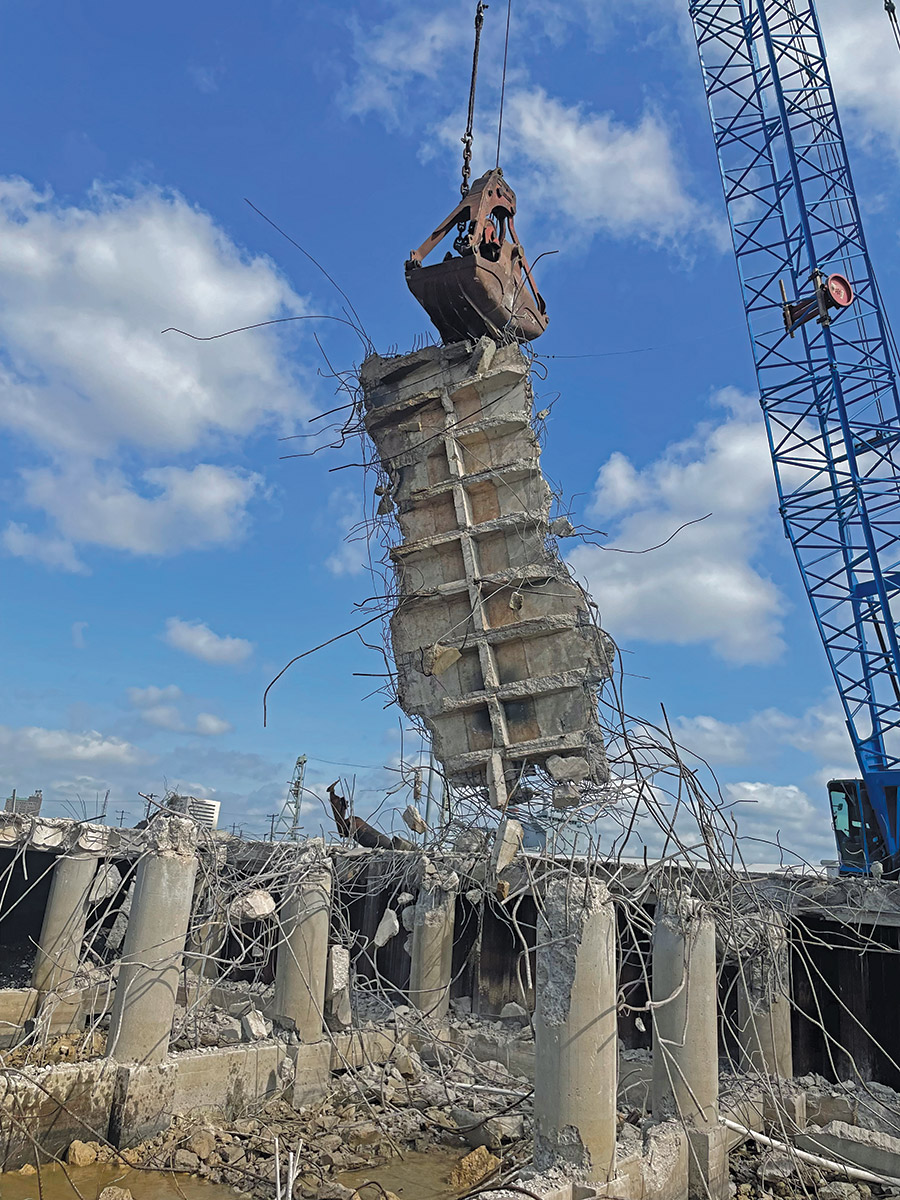
Before rebuilding could begin, crews had to remove massive debris from the river, some stuck in the mud.
Photo courtesy of McCarthy Building Cos.
Photos of the demolition process show concrete structural members that were several stories tall being pulled out of the river as well as steel pilings and twisted and corroded rebar. Despite the aged condition of concrete debris that was removed, an innovative and sustainable approach allows for the old dock to be recycled as slope protection for riprap used in reconstruction.
Wood describes the year-long demolition as risky with lots of unknowns. “The overwhelming challenge of how the dock collapsed made it very daunting,” he explains. “Some pieces of the old dock fell in the water, some were standing and some were ripped apart. The difficulty was we did not know how the structure would react when we started breaking it apart.” Wood adds that “most of the structure was underwater in near-zero visibility, adding another degree of risk.”
The collapsed dock, mostly underwater, was “an inconsistent structural failure and highly unstable.”
—Robert Wood, Senior Project Manager, McCarthy Building Cos
The demolition task began with McCarthy crews removing underwater walls weighing up to 200,000 lb and fabricating “punches”—large demolition tools—to smash concrete. McCarthy used a massive hydraulic shear to cut beams underwater, while employing a remote controlled hydrographic survey vessel with side-scan sonar and 3D modeling purchased last year for demolition and debris removal. Dubbed “Little Dude,” it can identify obstructions and modify pile locations based on existing wharf piles and accurately demolish existing wharf beams.
Kevin Drouet, an engineer at Lanier & Associates Consulting Engineers Inc., explains that even with the damaged dock still standing, it was vital that crews clear the riverbed before beginning construction to prevent underwater debris from hindering and obstructing the pile-driving process.
But the project also needed the human touch, literally, with McCarthy hiring specialists from Omega Divers, a Texas-based marine construction firm. “They had to feel everything by hand as there was zero visibility underwater,” says Wood.
The new dock, currently about 75% complete, will measure 1,300 ft long and 130 ft wide, with its middle section measuring 152 ft in width. Its construction will consist of concrete piles, cast-in-place concrete caps and beams, precast concrete deck panels and a concrete topping slab. McCarthy is self-performing all installation of concrete, piles and utilities, including water and sewer connections. Additionally, the company will provide landside earthwork and concrete paving.
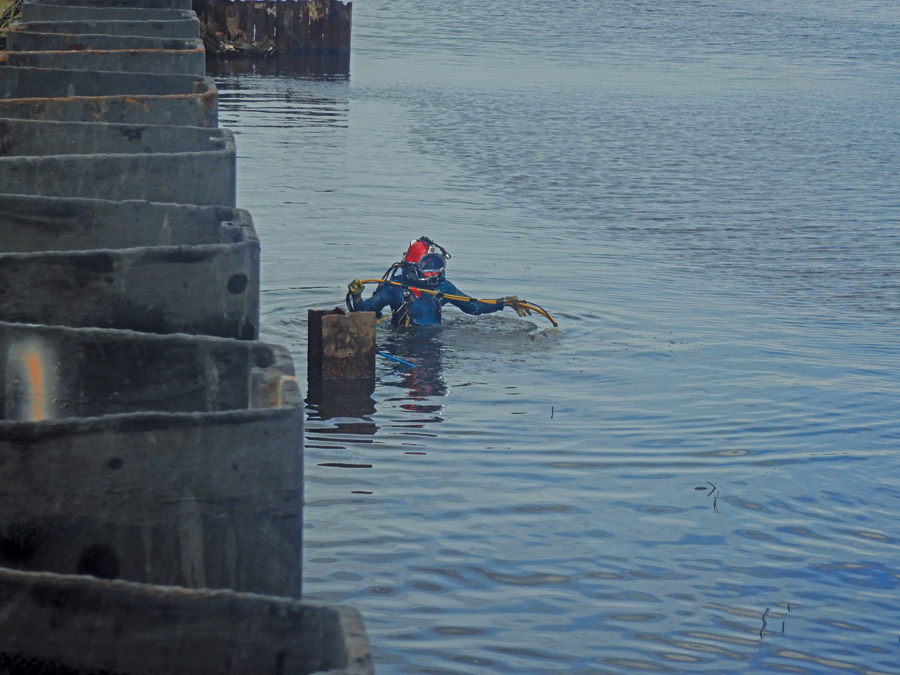
Zero visibility under water required divers to “feel everything by hand” during debris removal, says the port senior project manager.
Photo courtesy of McCarthy Building Cos.
Wood and project superintendent Ryan Everette say that it is paramount for the complete redesign of the Port of Beaumont terminal to be sustainable and resilient, which will be achieved through the use of innovative construction materials.
Building elements include using concrete piles that provide a corrosion-resistant foundation for extended resilienc, as well as a final concrete topping slab constructed using concrete with synthetic reinforcing fibers in addition to traditional welded steel wire mesh. This reinforcing material will provide a corrosion-resistant surface that will slow deterioration, he says. All precast panels will have carbon-capturing technology to reduce the new dock’s carbon footprint.
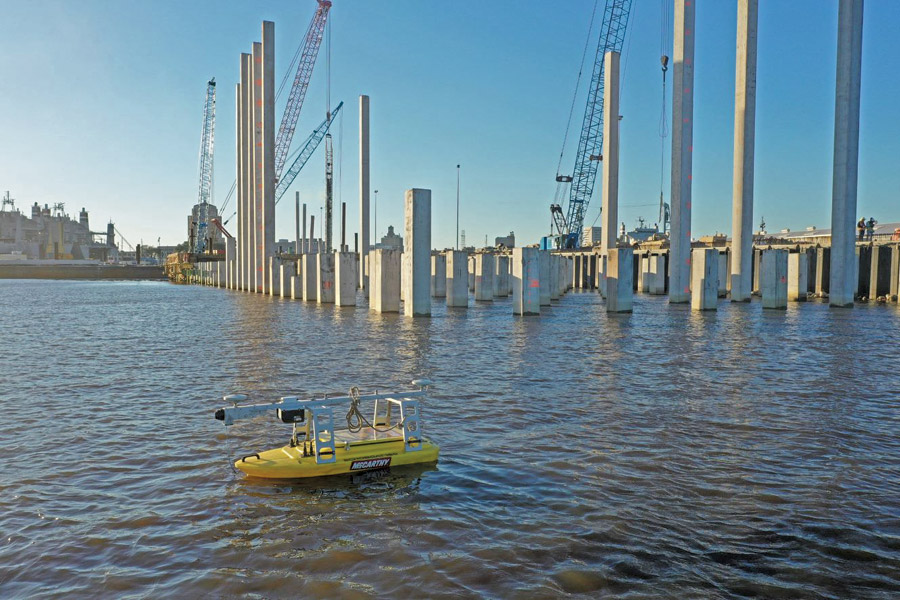
Crews used a sonar boat to help identify obstructions during demolition of the old dock structure.
The new fender system includes energy-absorbing components to reduce dock loads when a vessel comes abreast, which will extend the dock’s useful life and enable the port to handle a wide variety of vessel sizes, says Brett Harrell, McCarthy construction manager.
The Port of Beaumont is a breakbulk port that handles project cargo, dry and liquid bulk and roll-on cargoes. According to port statistics, it handled 7 million tons of cargo in 2021, with military equipment and petrochemical items making up most of that. McCarthy says Main Street Terminal 1 is the largest of 20 projects in the port’s 2022 capital improvement program.
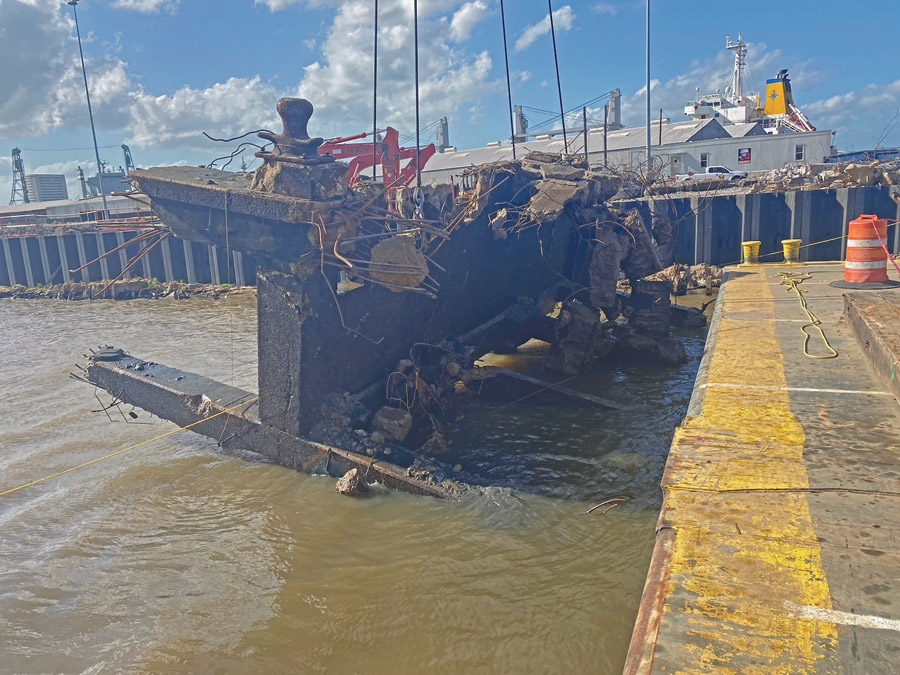
Crews removed terminal structure dating to the 1950s during demolition.
Everette says that 548 square concrete piles, each 30 ft by 30 ft and 90 ft long, will hold up the new dock, with the team seeking to place two to three piles daily. But piles are not always placed neatly in a row, given the amount of dock debris and earth scattered around the site, says Lanier & Associates’ Drouet. Avoiding obstructions is a significant challenge for engineering work on the new dock piling installation. To offset the risk, a waterside crane has a mounted dredge GPS system.
On a sweltering June day, work crews were busy tying rebar, driving piles and building forms to keep the project on schedule and on budget. Pile-driving was completed in mid July, McCarthy said on July 26.
Wood and Everette explained that McCarthy has hired local tradeworkers and surveyors, who all must have a U.S. Transportation Dept. security clearance because of the work at Beaumont, which is a key U.S. military shipping port. The company says it has recorded more than 140,000 work hours so far with no lost-time or recordable injuries. The “goal is zero safety incidents for this high-risk project and to finish on time and budget,” McCarthy says, adding that the current total project incident rate (TPIR) is 0.00 , which is “huge.”
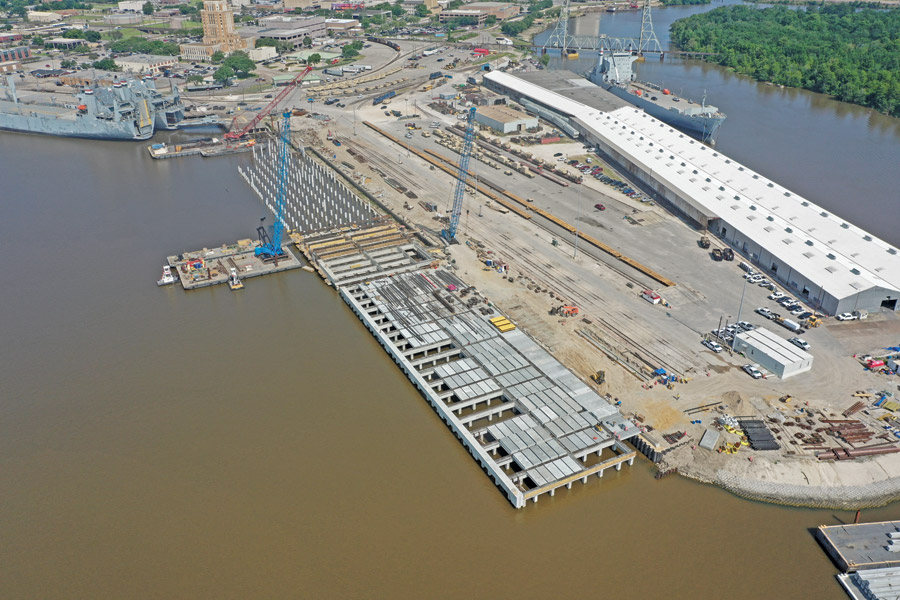
The new port terminal will be 15% larger than the former one.
Crews are on track to complete concrete cap installation on schedule and start landside work ahead of schedule, according to McCarthy. Completion is set for mid-2024. With the end in sight, the company says the project is running smoothly.
“A creative and collaborative team environment was required, constant planning sessions and always adjusting to new challenges,” says Wood.





